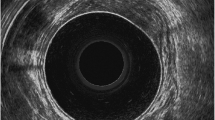Abstract
The purpose of the present study was to assess the size and configuration of the perirectal fatty tissues using magnetic resonance imaging, including the volume occupied by the rectum itself, and to establish a simple method by which such analysis could be derived. Included in the study were 25 consecutive patients without any large pelvic tumor (diameter of potential pelvic tumor less than 3 cm in any plane) referred for high-resolution pelvic MR imaging. The volume and cross-sectional parameters based on the amount of mesorectum to different sides of the rectum, and the total area occupied, including the rectum, were retrospectively measured using a transaxial three-dimensional T1-weighted gradient–echo sequence. The mesorectum, including the rectum within, occupied an axial area ranging from 320 to 5992 mm2, and a total volume of 54–323 ml. There was a good correlation between anteroposterior diameter of the perirectal fat at 4 cm below S1-2 and the left-to-right diameter 7 cm below S1-2, and the total volume. Furthermore, the form of mesorectal tissue differed significantly between male and female subjects. In male subjects, measurements in the anteroposterior dimension accurately reflected the volume of mesorectal tissue, while in women, assessment of both the anteroposterior and the size parameters of the mesorectum from the left to right were required for the best evaluation of the volume of mesorectal tissue. The amount of fat posterior to the rectum was significantly more in men than in women, with or without consideration of length of the pelvis. Finally, the contour of the mesorectal fascia was subject to impression by other nearby visceral organs. There is a great individual variation in the amount of mesorectal fat, and in morphometric parameters between the two sexes. The morphological variations of the mesorectum can be assessed by magnetic resonance imaging using a formula based on two simple measurements of the anteroposterior and left-to-right dimensions.






Similar content being viewed by others
References
Faivre J, Bouvier AM, Bonithon-Kopp C (2002) Epidemiology and screening of colorectal cancer. Best Pract Res Clin Gastroenterol 16(2):187–199
Elmas N, Killi RM, Sever A (2002) Colorectal carcinoma: radiological diagnosis and staging. Eur J Radiol 42(3):206–223
Bernick PE, Wong WD (2000) Staging: what makes sense? Can the pathologist help? Surg Oncol Clin N Am 9(4):703–720
Hermanek P, Wiebelt H, Staimmer D, Riedl S (1995) Prognostic factors of rectum carcinoma—experience of the German multicentre study SGCRC. German Study Group Colo-rectal Carcinoma. Tumori 81(3 Suppl):60–64
Quirke P, Dixon MF (1988) The prediction of local recurrence in rectal adenocarcinoma by histopathological examination. Int J Colorectal Dis 3(2):127–131
Rullier E, Laurent C (2003) Advances in surgical treatment of rectal cancer. Minerva Chir 58(4):459–457
Kapiteijn E, van de Velde CJ (2002) The role of total mesorectal excision in the management of rectal cancer. Surg Clin North Am 82(5):995–1007
Heald RJ, Husband EM, Ryall DH (1982) The mesorectum in rectal cancer surgery—the clue to pelvic recurrence. Br J Surg 69(10):613–616
Martling AL, Holm T, Rutqvist LE, Moran BJ, Heald RJ, Cedemark B (2000) Effect of a surgical training programme on outcome of rectal cancer in the County of Stockholm. Stockholm Colorectal Cancer Study Group, Basingstoke Bowel Cancer Research Project. Lancet 356 (9224):93–96
Wiggers T, van de Velde CJ (2002) The circumferential margin in rectal cancer. Recommendations based on the Dutch Total Mesorectal Excision Study. Eur J Cancer 38(7):973–976
Brown G, Radcliffe AG, Newcombe RG, Dallimore NS, Bourne MW, Williams GT (2003) Preoperative assessment of prognostic factors in rectal cancer using high-resolution magnetic resonance imaging. Br J Surg 90(3):355–364
Brown G, Richards CJ, Newcombe RG, Dallimore NS, Radcliffe AG, Carey DP, Bourne MW, Williams GT (1999) Rectal carcinoma: thin-section MR imaging for staging in 28 patients. Radiology 211(1):215–222
Beets-Tan RG, Beets GL, Vliegen RF, Kessels AG, Van Boven H, De Bruine A, von Meyenfeldt MF, Baeten CG, van Engelshoven JM (2001) Accuracy of magnetic resonance imaging in prediction of tumour-free resection margin in rectal cancer surgery. Lancet 357(9255):497–504
Torkzad M, Lindholm J, Martling A, Blomqvist L (2003) Retrospective measurement of different size parameters of non-radiated rectal cancer on MR images and pathology slides and their comparison. Eur Radiol 13(10):2271–2277
Blomqvist L, Rubio C, Holm T, Machado M, Hindmarsh T (1999) Rectal adenocarcinoma: assessment of tumour involvement of the lateral resection margin by MRI of resected specimen. Br J Radiol 72(853):18–23
Glimelius B, Gronberg H, Jarhult J, Wallgren A, Cavallin-Stahl E (2003) A systematic overview of radiation therapy in rectal cancer. Acta Oncol 42(5–6):476–492
Acknowledgements
The authors would like to express their utmost gratitude for the statistical assistance of Johan Almbrandht and Henrik Hellborg, both from the Oncologic Center, Karolinska University Hospital.
Author information
Authors and Affiliations
Corresponding author
Rights and permissions
About this article
Cite this article
Torkzad, M.R., Blomqvist, L. The mesorectum: morphometric assessment with magnetic resonance imaging. Eur Radiol 15, 1184–1191 (2005). https://doi.org/10.1007/s00330-005-2657-5
Received:
Revised:
Accepted:
Published:
Issue Date:
DOI: https://doi.org/10.1007/s00330-005-2657-5




